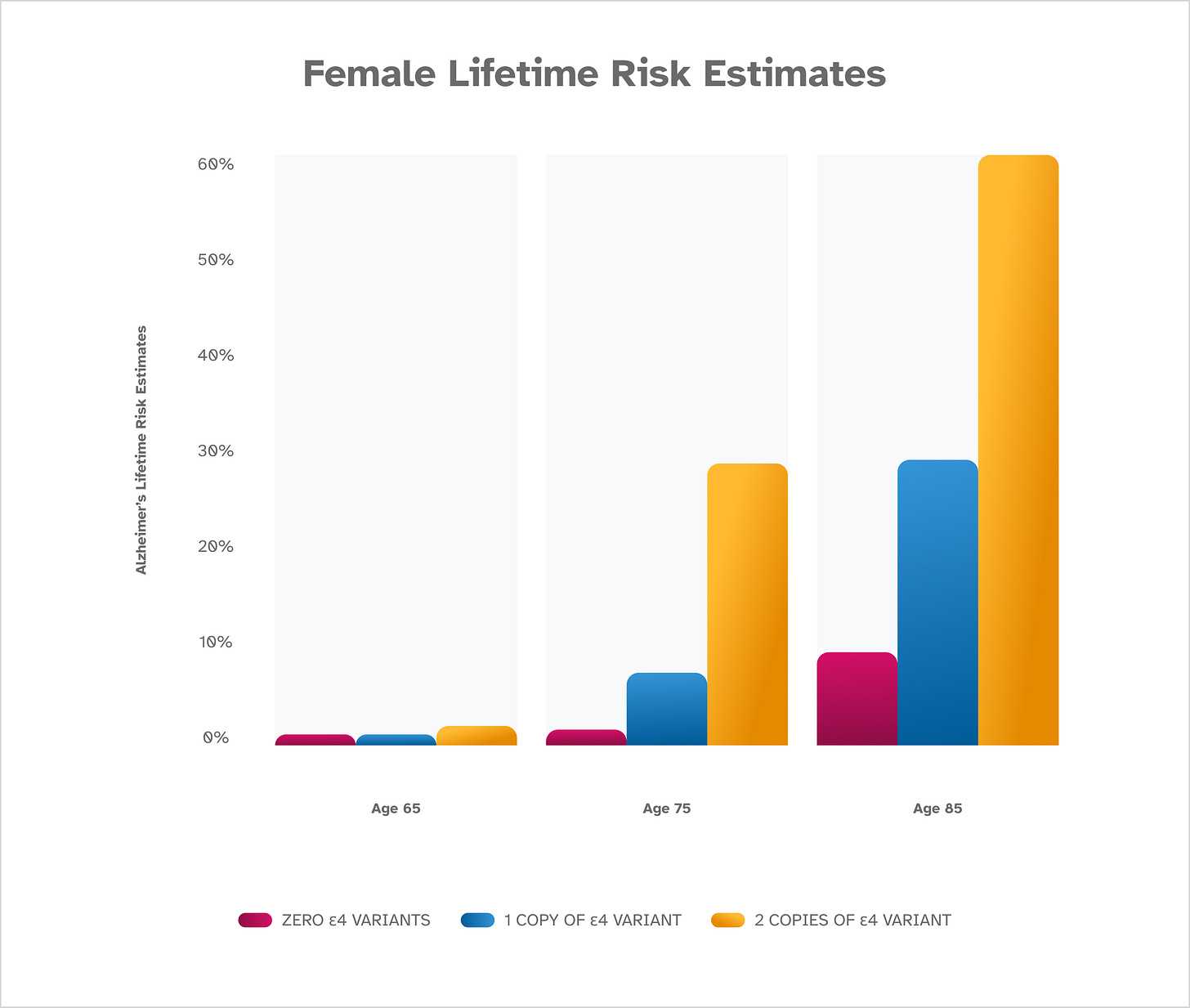A Simplified Overview of APOE4 - the Alzheimer's Gene
The Alzheimer’s Hub of Hope has four sections: Heroes, Highlights, Headlines and Helpers/Caregivers. This post is aligned to the headlines section.

Many people with a family history of Alzheimer’s are concerned that genetics predisposes them or guarantees that they will develop the disease. Genetics do play a role but it is not deterministic; meaning that people even with the worst genetic disposition may not develop late onset alzheimer’s1.
APOE4 is known as the Alzheimer’s gene because it increases the risk of developing the disease. A person could have 0, 1 or 2 copies of the gene allele. The NIH estimates that 15% to 25% of people have one copy of this gene allele, and 2% to 5% carry two copies2. So in the most conservative estimate 30% of the population are at higher risk based on genetics.
23andme3 breaks down the distribution of APOE4 allele copies by ethnicity from their database. It is interesting to see the variability across groups.
APOE4 Prevalence by Ethnicity
The Risk of Suffering from Alzheimer’s Increases with APOE4 Allele Number, Sex and Age
23andme estimates that one copy of the APOE4 allele increases risk 3-fold, and two copies increases risk 8- to 12-fold. However, there is significant variability across sex, age and genetics.
For example, a 65 year old female with zero allele copies has just slightly lower risk than a same aged female with 2 copies but a two copy 85 year old female would have about eight times the risk of an 85 year old female without any copies. So age really matters. The charts below are very insightful. A 65 year old female with the largest genetic risk (two copies) has less overall risk than an 85 year old female with the least genetic risk (zero copies).
23andme genetic testing includes APOE4 late Alzheimer’s status and can be purchased here.
What other risk factors for Alzheimer’s disease are there?
Based on the charts above, an 85 year old female with two copies (eg. the largest genetic risk) has a 60% risk of Alzheimer’s and a male equivalent has a 50% risk so there must be something else that impacts a person’s risk. (So even at 85 years of age only about half of the population with two copies of APOE4 will suffer from Alzheimer’s; so other factors may reduce the risk).
23andme has determined these non-genetic factors are associated with higher or lower risk for Alzheimer’s. Many of these factors are interrelated — diet, exercise, and heart health, for instance. Here’s what we know about each one:
Age
The risk of Alzheimer’s disease increases greatly as a person ages. This condition is most often diagnosed in people over the age of 65.
Sex
More females than males have late-onset Alzheimer’s disease. This may be partly due to the fact that women tend to live longer than men, but biological and lifestyle differences likely also play a role.
Family History
Family history also matters for Alzheimer’s disease. People who have a parent or sibling with Alzheimer’s are more likely to develop the condition. This could be due to shared genetics, but it could also reflect a shared home environment and lifestyle, or a combination.
Heart Health
Many studies have investigated the relationship between cardiovascular risk factors and Alzheimer’s disease. Evidence suggests that factors that increase the risk of cardiovascular disease (obesity, high cholesterol, high blood pressure, type 2 diabetes, and smoking) also increase the risk of Alzheimer’s disease.
Diet
Understanding the effects of diet on Alzheimer’s disease risk is an active area of research. Studies suggest a diet with plenty of green leafy vegetables, fruits, whole grains, and healthy fats such as those found in fish, nuts, and olive oil is associated with a reduced risk of developing Alzheimer’s disease. (Note: my MIND study post here highlights research that disputes the cognitive benefits of eating the above mentioned diet).
Exercise
Understanding the effects of exercise on Alzheimer’s risk is an active area of research. Evidence suggests that exercise benefits the brain and decreases the risk of developing Alzheimer’s disease.
Intellectual activity
Fewer years of education has been associated with a greater risk of developing Alzheimer’s disease later in life. The cause of this association is unclear. It could be that lower education levels reflect lower socioeconomic status, which may limit a person’s access to affordable health care and nutritious food.
Race and Ethnicity
Late-onset Alzheimer’s disease affects people of all races and ethnicities. About 1 in 10 Americans age 65 and older is affected by Alzheimer’s disease. Elderly African Americans and Hispanic/Latin Americans are more likely to develop the condition than people of other races and ethnicities. For reasons not yet fully understood, other genetic factors in addition to the APOE4 variant – and non-genetic factors – seem to contribute to a higher risk of late-onset Alzheimer’s disease among these population group
The Benefit of Exercise by APOE4 Status
Recent research from 23andMe shows that adults over the age of 60 who average at least 30 minutes of exercise per week are less likely to have Alzheimer’s disease regardless of the number of APOE4 copies. This demonstrates the significant benefit of life style factors in decreasing risk regardless of genetic status.
These findings are based on January 2023 data from about 1,000,000 consented 23andMe research participants over the age of 60.
The Take Away
Genetics play a roll in developing Alzheimers so I suggest everybody know their late onset APOE4 status via 23andme or some other service. People with one or two copies of APOE4 should discuss this with their medical practitioner and be deligent in addressing their added risk with environmental and life style changes.
Don’t forget to checkout the archive here.
Early onset Alzheimer’s where the disease manifests as early as the third or fourth decade of life have a different genetic make up and isn’t part of this post.
https://www.nia.diligent.gov/health/alzheimers-disease-genetics-fact-sheet#:~:text=APOE%20%CE%B54%20increases%20risk%20for,to%205%25%20carry%20two%20copies.
https://www.23andme.com/topics/health-predispositions/late-onset-alzheimers/





